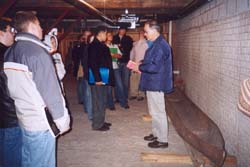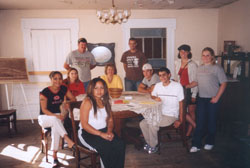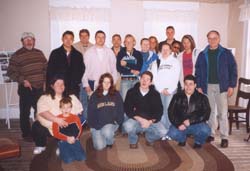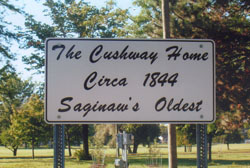
Home
- Artifacts
- Buildings & Businesses
- Churches
- Holidays & Celebrations
- Counties/Locations
- Delta College
- Early Settlers
- Ethnic Background
- Local, Michigan, U.S. and World Events
- Family Genealogy
- Farming
- Libraries & Museums
- Local Sites
- Logging
- Musicians, Artists & Famous People
- Nature, Weather & Four Seasons
- Railroads
- Schools
- Sports
The Cushway Home—Saginaw County's Oldest Home
 |
 |
| Delta College students tour the Cushway Home as part of their study of local history. Saginaw historian,Tom Mudd, provided history of the home, from the original owner in1844, a blacksmith, to the present custodians and renovators, the Saginaw Historical Society. | |
 |
 |
| Delta College students and Tom Mudd pose for group photos in dining room and parlor of Cushway Home. |
History of the Cushway Home
Benjamin and Adelaide Cushway
Benjamin (1810-1881) and Adelaide (1812-1877) Cushway (formerly Cauchois) were prominent settlers in the Saginaw Valley. Both were descended from early French-Canadian families of Detroit. Between 1827 and 1834, Benjamin apprenticed with Harvey Williams of Detroit, a notable blacksmith and one of Michigan's first. Harvey Williams built the first two sawmills along the Saginaw River in 1834 and 1837. Benjamin and Adelaide were married in 1833. In 1834, three years before Michigan achieved statehood, Territorial Governor Lewis Cass appointed Benjamin official blacksmith to the Chippewa (Ojibwa) Indians at the Saginaw Indian Agency. Cushway served in that capacity until 1866 and was highly popular with the Indians due to his standing up for them and for his ability to tell stories in their own languages. In 1844 the Cushways built their home on the site of what was once Fort Saginaw. From 1837 to 1844, the Cushways were serving the Indians at Lower Saginaw (Bay City) at what is today called Salzberg, their log cabin just to the west of the Lafayette Street Bridge.
The Cushway House
 |
| The written and visual works in Mid-Michigan Remembers-Stories about Us were chosen on the basis of their quality, diversity, community interest and appeal. Views expressed do not necessarily reflect those of the College. This space is provided as a service by Delta College. |